Marcelo Bielsa vs Pep Guardiola. The master vs the student. Football fanatics waited for seven long years for another Bielsa vs Pep faceoff. The two philosophers of the game who has a lot of influence in how the modern football is viewed gave the fans an exhilarating experience on Saturday, a game of football that would be remembered for decades to come.
Manchester City started the game on a strong note giving the master a taste of his own medicine. However, in the second half, the master bounced back to give the mister plenty to think.
In this tactical analysis, we will discuss the tactics of both the managers and the intricacies of the game. This analysis will also discuss in detail the changes Bielsa made in the second half to bring Leeds United back into the game.
Line-up
Marcelo Bielsa had to make a forced change in the form of Jack Harrison who was ineligible to face his parent club. Ezgjan Alioski replaced him in the left-wing. Patrick Bamford, Mateusz Klich, Tyler Roberts, and Hélder Costa formed the front five in a 4-1-4-1 line-up. Kalvin Phillips acted as the lone pivot in front of Stuart Dallas, Liam Cooper, Robin Koch, and Luke Ayling. Illan Meslier started in between the sticks.
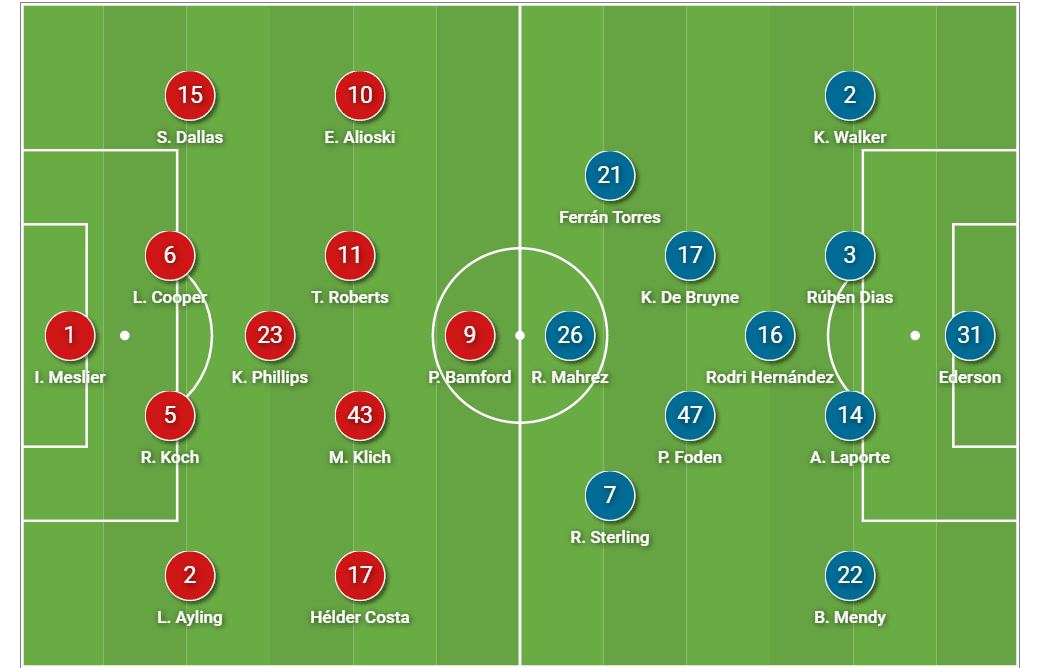
Pep Guardiola started with his preferred 4-3-3 formation but made few changes from the previous Premier League fixture against Leicester City. Fernandinho started from the bench and he was replaced by Ferran Torres, who started as the right-winger. He was accompanied by Riyad Mahrez who played as a false 9 and Raheem Sterling in the left-wing. The midfielder consisted of Kevin De Bruyne, Phil Foden, and Rodri. Ederson was protected by Benjamin Mendy, Aymeric Laporte, Rúben Dias, and Kyle Walker in the defence.
Man City’s build-up against Leeds’ press
Leeds pressed Manchester City in two ways. One, man-marking along with pendulum press of the pivot and another, a 4-2-3-1 man-marking.
Below is an image that shows Leeds man-marking which initiates the pendulum pressing of the pivot. Eight players man-marked initially, Costa remained in between Mendy and Laporte, close to the French centre-back, and Cooper or Koch remained a free man not marking anyone, depending upon the movement of Mahrez.

Leeds did not want to give Ederson much time with the ball owing to his capabilities with the ball. When Ederson had the ball, Bamford moved up to press him putting a cover shadow on the pivot (Rodri) and Roberts moved from pressing Dias to marking the pivot and if the Brazilian goalkeeper passed the ball to Dias, Roberts moved to press Dias again and Bamford falls back to mark the pivot.

To move away from the pendulum press and open up a passing lane for Ederson, Rodri tried to move away from both the players.

As can be seen in the image above, when Bamford moved up to press Ederson, Rodri moved to the left away from Roberts leaving Roberts in an unknown territory. However, Bamford did an amazing job to cover shadow Rodri perfectly and block the passing lane.
The other method city adopted was for their centre-backs to carry the ball forward. Rodri remained tied in the pendulum press but he distanced Bamford from Roberts leaving Bamford with both the centre-backs to mark and giving Leeds a 4-2-3-1 structure.

It was impossible for Bamford to mark both the centre-backs at once which prompted the ball carrier centre-back to carry the ball forward in the opposition half. This was a common method City utilised in this match. The main idea was to shrug off the man-markers through dribbling and movements.
This put the Leeds press in a conundrum and they made a grave mistake once in the 30th minute which could have cost Leeds dearly.

Bamford and Roberts miscommunicated and decided to mark both the centre-back leaving Rodi completely unmarked.

Rodri carried the ball to the opposition half with Roberts lagging behind. However, a poor pass from Rodri broke City’s attack.
City players were instructed to use a lot of dribbling to shrug off the man-markers.

Here, Mendy dribbled past Costa which prompted Klich to lose focus off KDB. Mendy attracted Klich and passed the ball to KDB and created a dangerous situation. Phillips was massive in this instance and won the ball back for Leeds thus preventing Leeds from conceding early on.
City players also used a lot of shimmy movements to shrug off Leeds man-markers along with dribbling.

Here, Mendy passed the ball to Mahrez who played as a ‘false 9’ and played a first time ball to Sterling who made a backward movement initially to shrug off Ayling and then a forward movement past the Leeds full-back.
Leeds’ first half conundrum
Leeds United struggled in the first half to bypass Manchester City’s press. The Whites accumulated 0.91 xG in the first half compared to 1.58 in the second half. The home time had four shots in the first half compared to eight in the second. Leeds did manage to have few shots in the first half but it did not come from build-up from the back. Why was it so?
Leeds’ use of flanks in the build-up is known to all by now. Even against Man City, the Whites have paced their attack 74% from both the flanks.
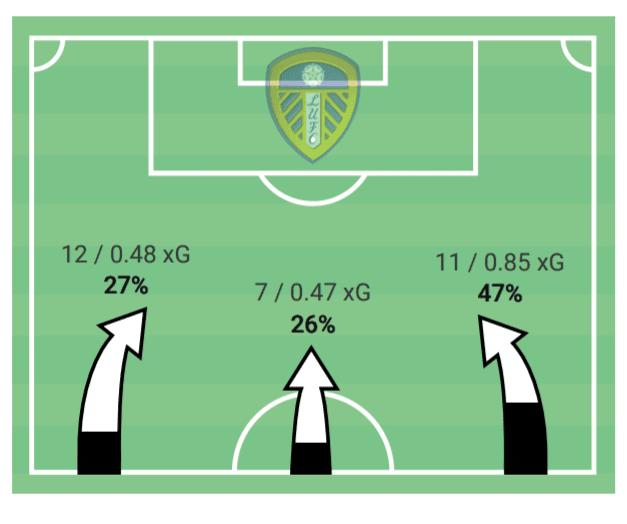
The home team targeted to play through both the flanks (mostly left) as well as the half spaces (mostly right) in between Man City’s second and the last line of defence, and Kalvin Phillips.
Man City set up in a 4-3-3 Liverpool-alike high block with Mahrez putting a cover shadow on Phillips. Sterling (LW) and Torres (RW) sat between their respective opposition centre-back and the full-back. The three midfielders of the Cityzens sealed the press preventing any Leeds midfielder to operate in between.
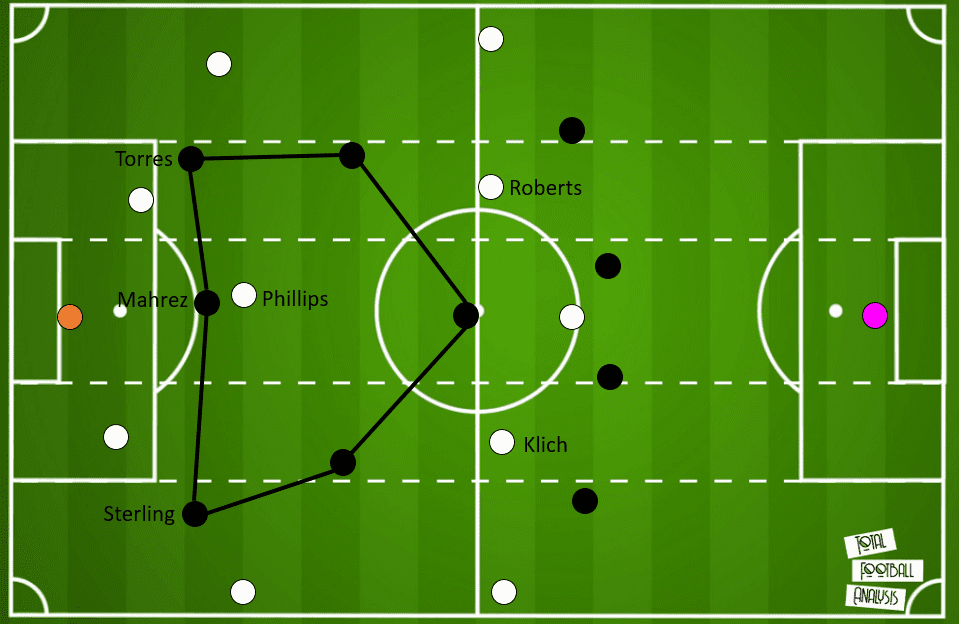
The Leeds unit set-up as shown in the picture above with the five attacking players in 4-1-4-1, positioning relatively higher and vacating the central region in their own half.
When the Leeds goalkeeper played a pass to the centre-back, the winger of that respective vertical half presses the centre-back diagonally putting a cover-shadow on the full-back. The midfielder of that vertical half moves slightly towards the flank to cover his winger in case Leeds find a way to their full-back.
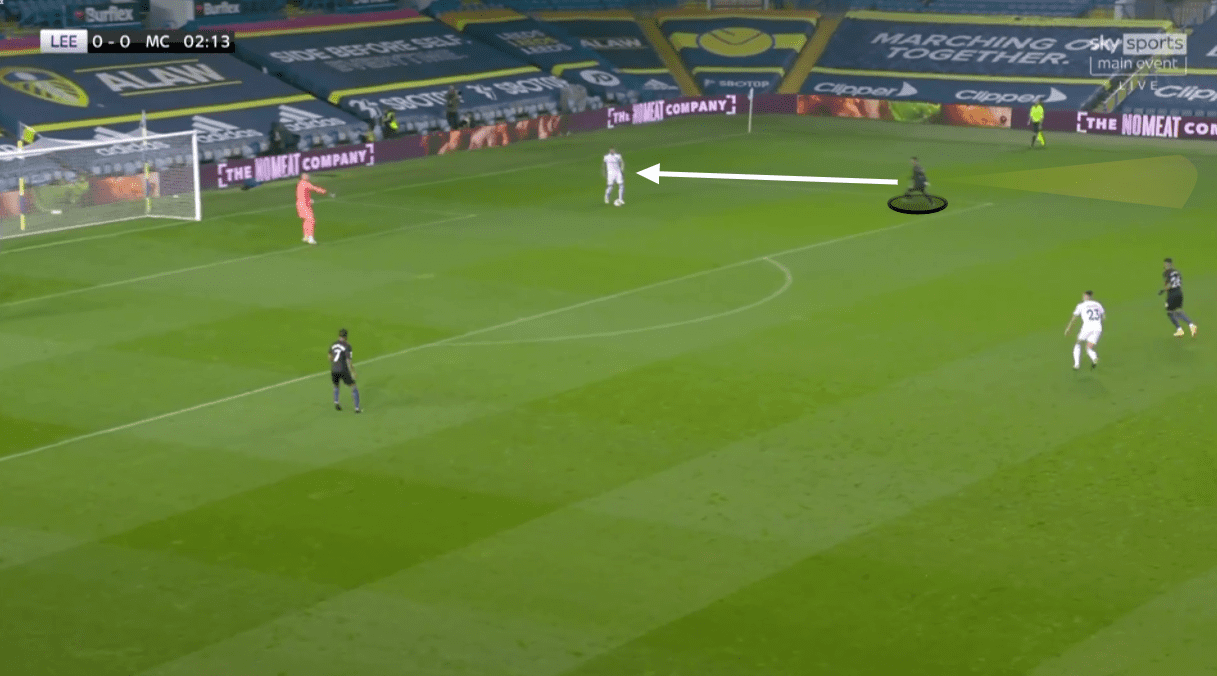
Here, Meslier played a pass to Cooper. As soon as he passed the ball, Torres pressed Cooper out to in, putting a cover shadow on Dallas, thus blocking the passing lane to the left-back. When Cooper passed the ball back to the goalkeeper, Torres had the license to go ahead and press Meslier with the same body orientation thus forcing Meslier to play to the other vertical half.
Meslier tried to find Ayling through a lofted ball, as Sterling moved up to press Koch with the same body orientation.
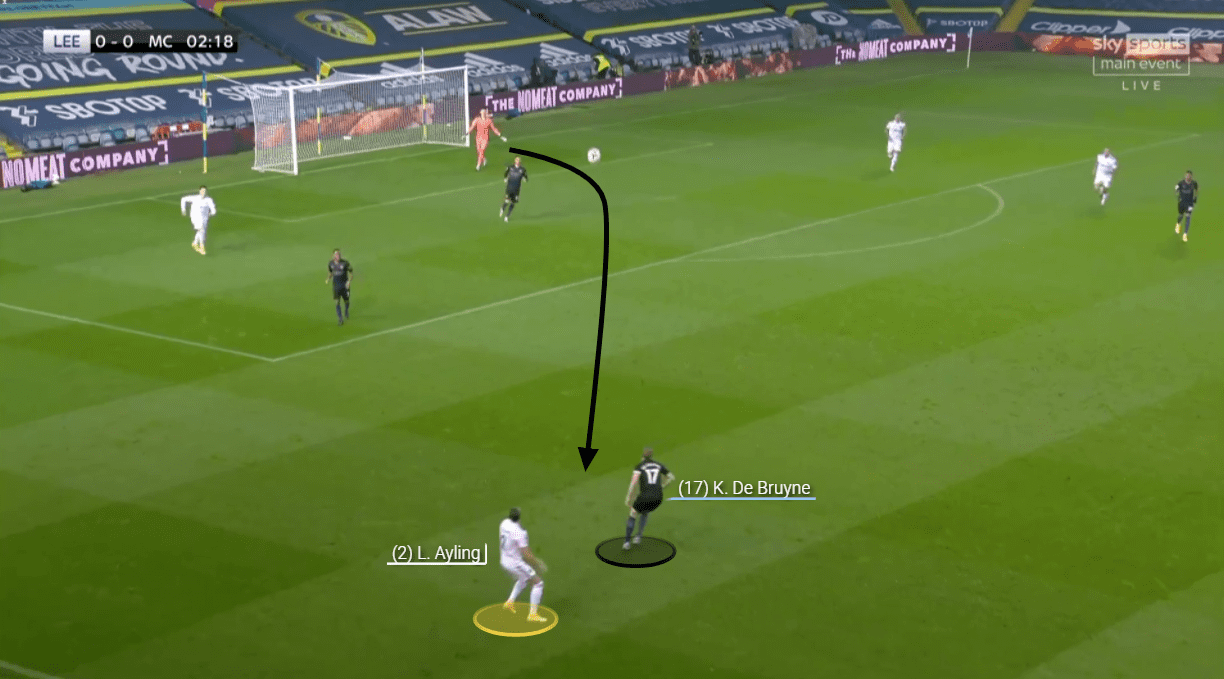
As soon as Meslier played the ball to the right-back, De Bruyne was there to cover Sterling and intercept the ball. It was difficult for Leeds to access the flanks through this method as City’s front six was up to the task.
Even when Meslier managed to play the ball to the full-backs, they would have to look for a central passing option or go long because of City’s pressing structure. When the full-backs managed to find a central passing option, he would be caught in a City trap.
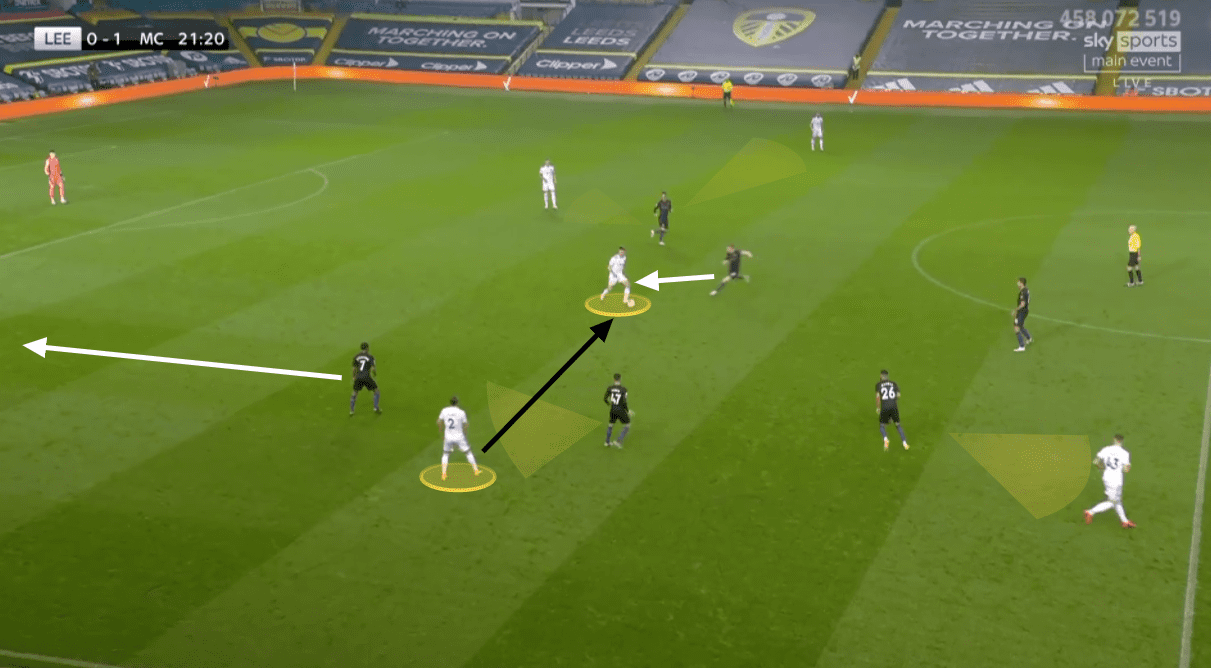
When City prevented Leeds to play from the flanks, the Whites tried to access the half space in between Man City’s second and last line of defence, which was the home side’s most frequently used space.
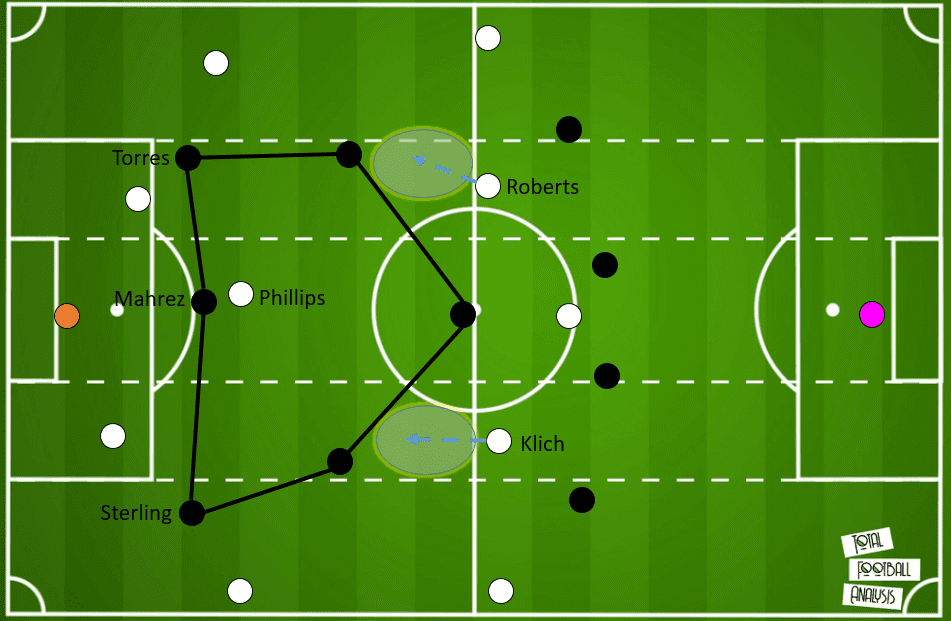
Klich and Roberts operating in both the half spaces positioned themselves higher but used to drop down just to the blindside of the City midfielders when the ball was targeted to them. It fooled the City defenders to not move up with them as it was the midfielders’ space to cover as well as they wanted to keep the defensive shape (otherwise Bamford might exploit the space). The City midfielders too can’t track Roberts and Klich as they drop unexpectedly and swiftly to their blindside.
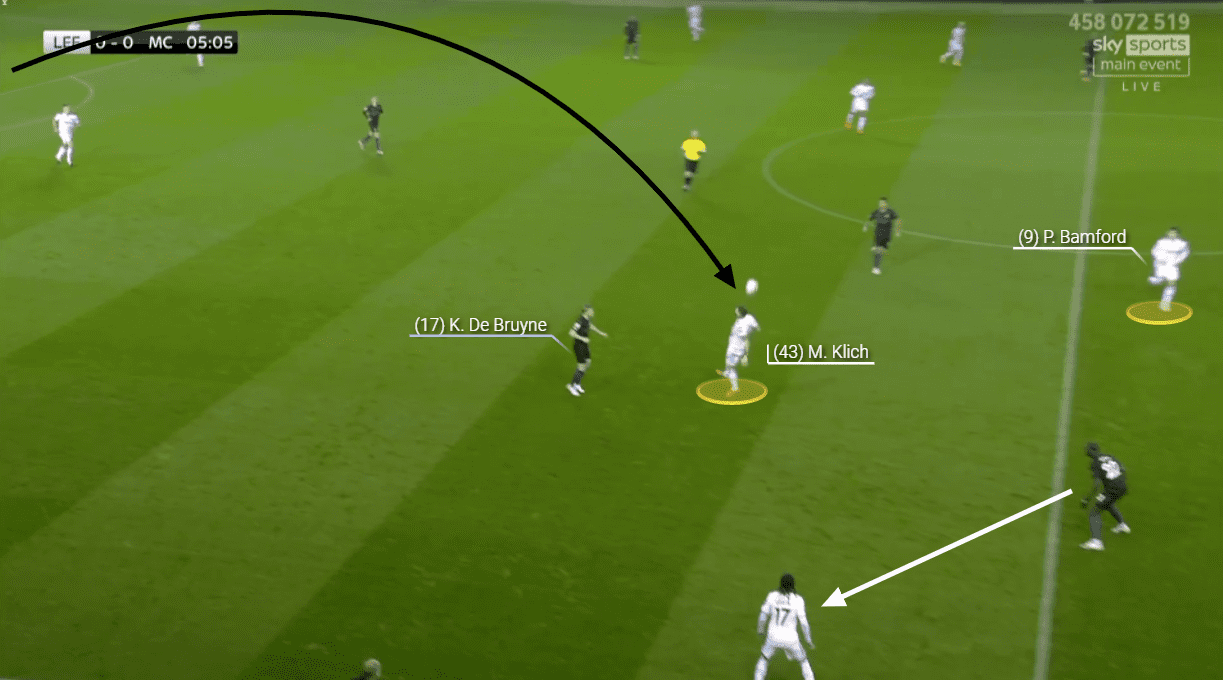
Here, Meslier played a perfectly weighted ball to Klich but the Polish international failed to judge the flight of the ball which resulted in a Leeds turnover. Mendy can’t move up to cover KDB as he has to mark Costa on the left flank. Laporte (LCB) can’t move up as Bamford lurked in his space. KDB failed to track Klich’s movement as the Polish international operated on his blindside.
The other method by which Leeds tried to bypass City’s press was by finding Phillips unmarked which looked like an impossible task in the first half.
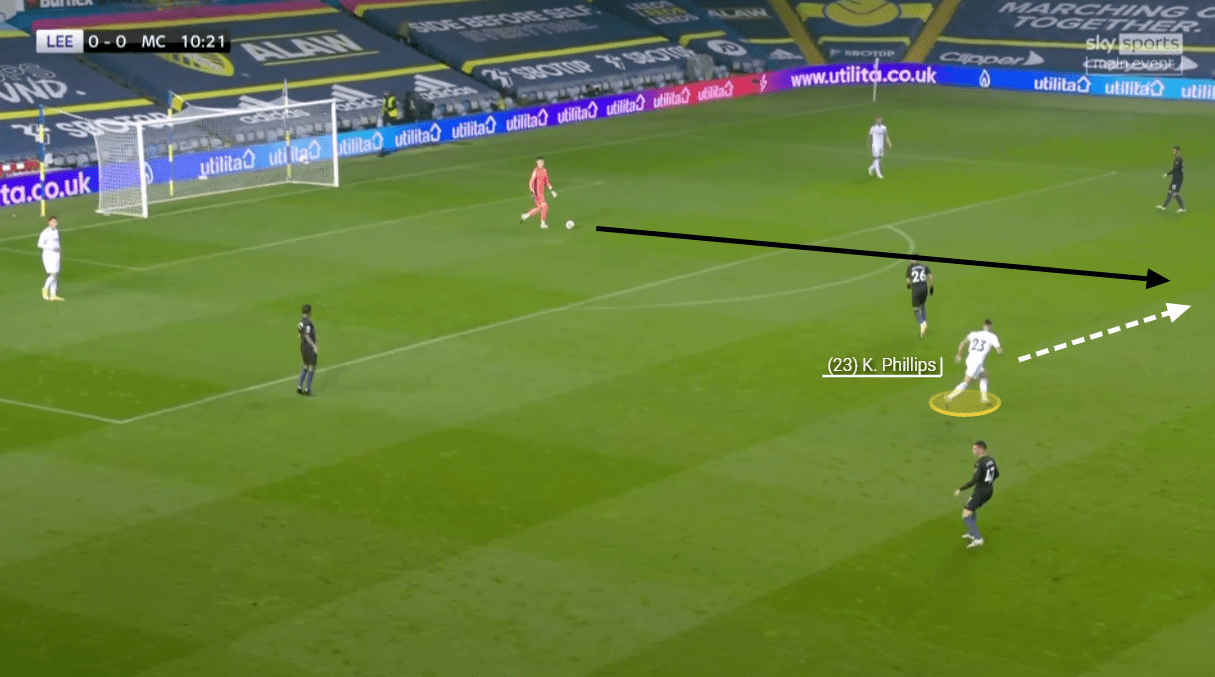
Here, Phillips tried to move from the cover shadow of Mahrez and find himself in an unmarked space.
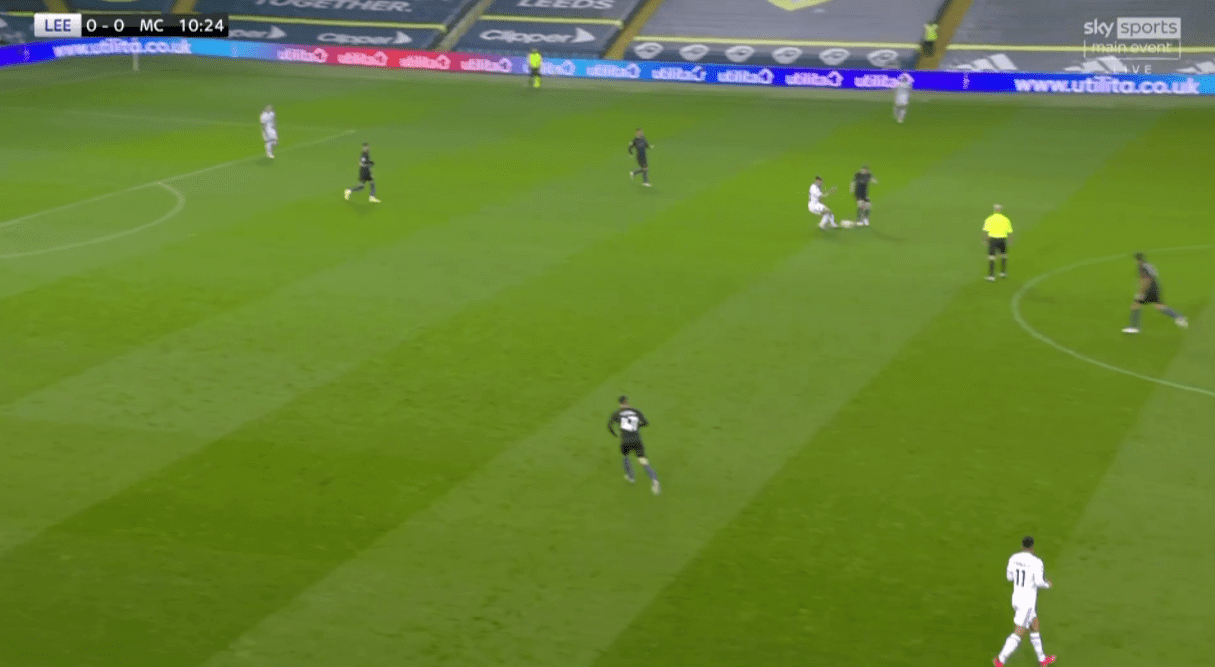
As soon as Meslier tried to find Phillips through a pass, KDB was there to cover for Mahrez and intercepted the pass, which again resulted in a Leeds turnover and the Whites were extremely lucky not to concede from this situation.
Leeds struggled in the first half to bypass Man City’s press when the Whites tried to play out from the back. However, Whites did manage to bypass the City press comfortably in the first half, once.
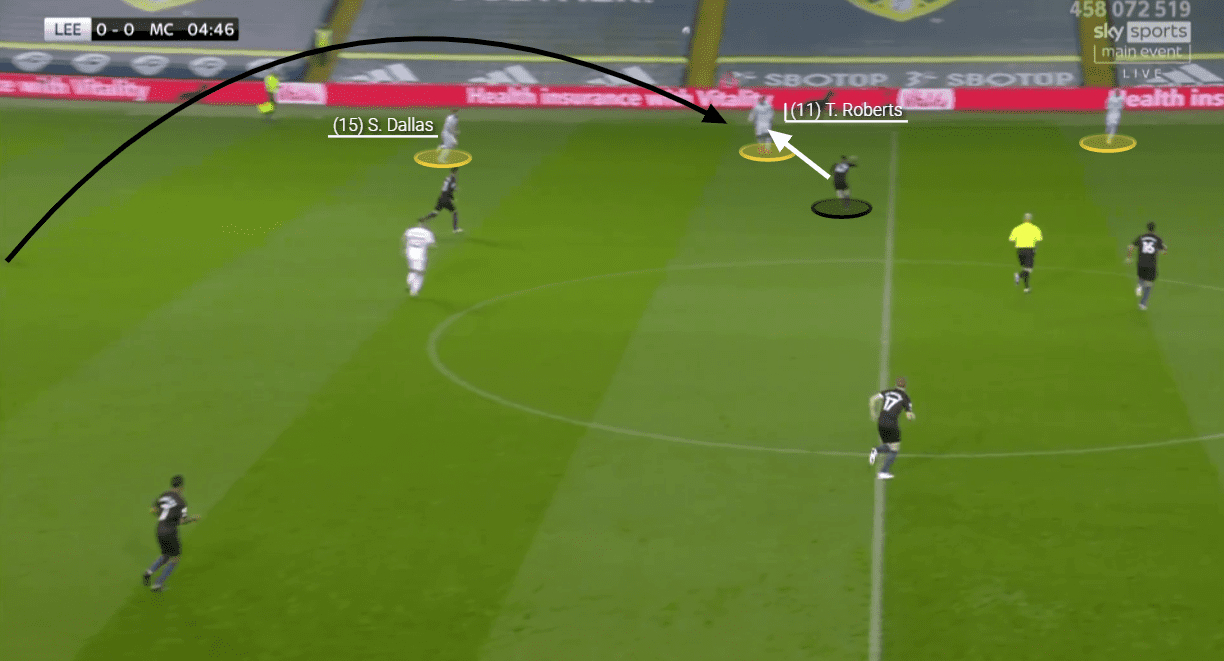
Here, Roberts moved from the half space towards the left flank which made it impossible for Foden (RCM) to mark Roberts. As you can see, Foden struggling to press Roberts.
Since Mahrez cover shadowed Phillips, he had to be in front of Phillips. Thus, it was impossible for the Algerian to cover Phillips if the England midfielder was used as a third man.
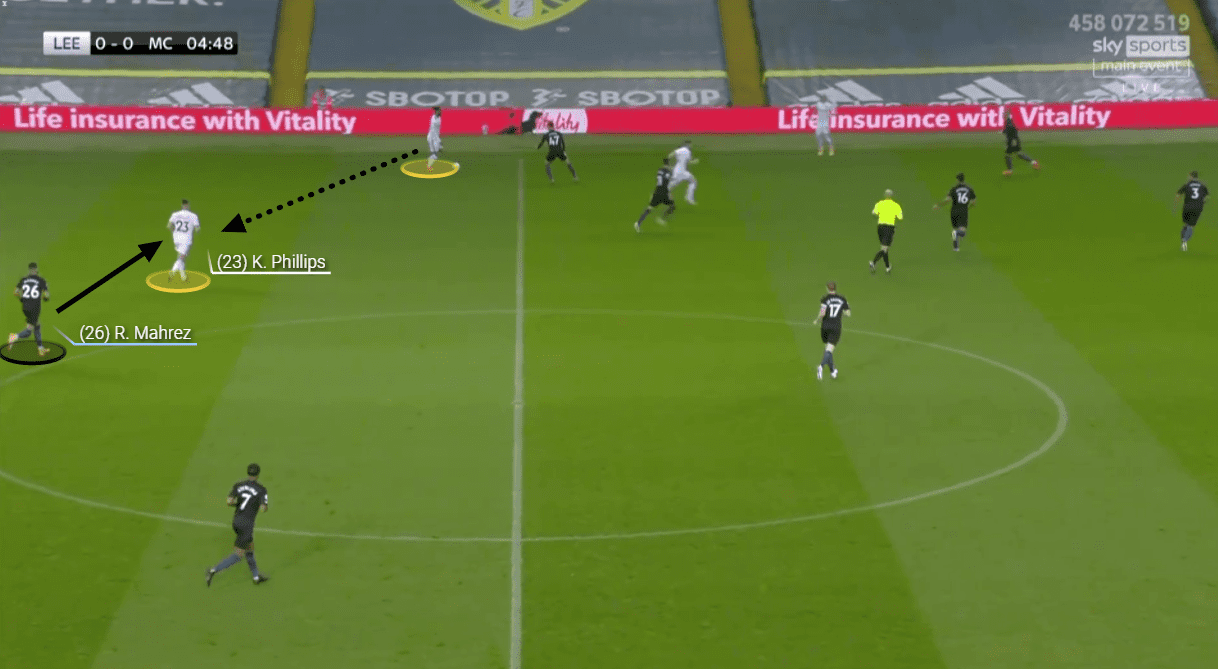
Here, Roberts received the ball on the left flank from Koch and he was met by Foden. Dallas moved up dragging Torres along with him which left Phillips in an unmarked area with Mahrez struggling to track the English midfielder.
This might not have been a planned approach from Leeds as the Whites did not attempt this method again in the first half. However, it led to the thought of using Phillips as the third man as well as to exploit the blindside of the midfielders extensively through a more technically gifted player in the second half.
Leeds successfully bypassing Man City’s press in the second half
Leeds implemented a few principles of play in the second half which the Leeds coaching staff thought could derail the City press with glimpses from the first half. The Whites implemented pass and move and rotation extensively, used Phillips as the third man, and began to overload one vertical half of the field. Along with these, Leeds continued to exploit the blindside of the midfielders in between the second and the last line of defence with a more technically gifted player in the form of Rodrigo who was introduced early in the second half in place of Roberts.
The pass and move approach could have been influenced by the sequence when Roberts moved to the flanks and Dallas’ movement helped Leeds to use Phillips as the third man. The difference was that instead of a midfielder (who positioned himself in the half space), the wingers were asked to drop deeper and help in the build-up.
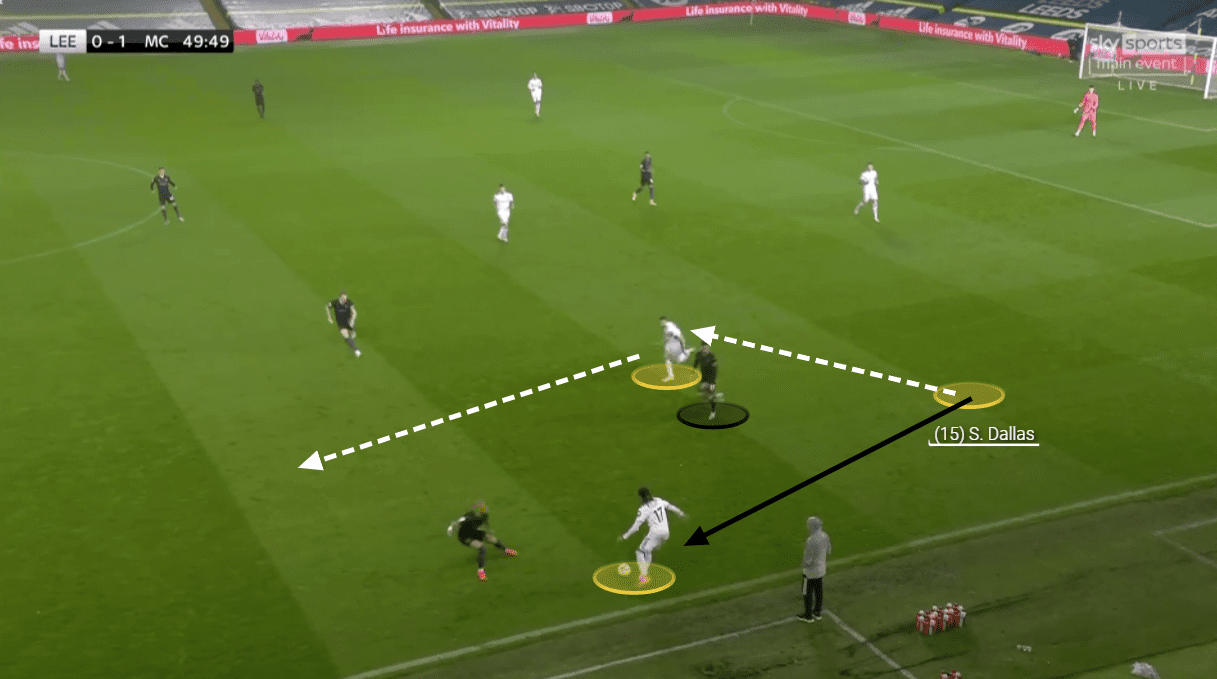
Here, Dallas passed the ball to Costa and moved, dragging away Torres along with him once again.

It opened up space for and the Portuguese who had two options in the form of Phillips and Cooper to be used as the third man. Costa found Phillips but Mahrez was able to track Phillips in time and prevent him from progressing the ball in that instance but it did not lead to a Leeds turnover and the home team again started to build-up from the back.
However, after just two minutes Leeds created a massive chance for themselves through ‘pass and move’.
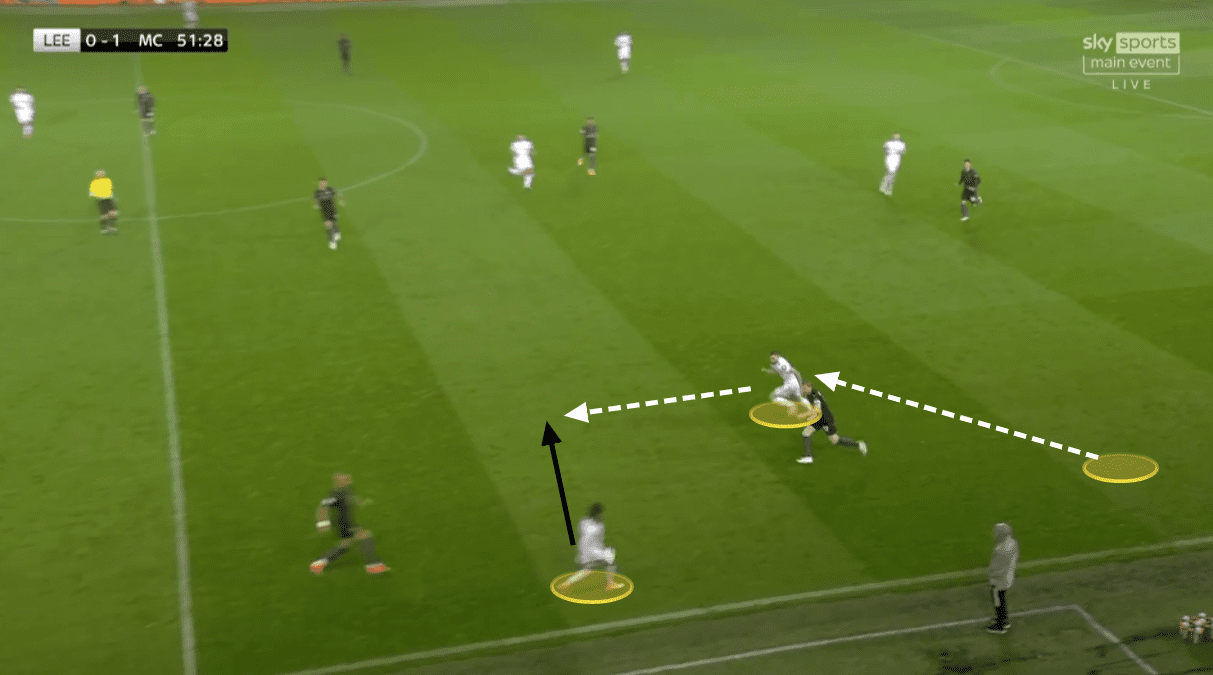
Again, Dallas passed the ball and made an underlapping run dragging away KDB along with him, in this instance. KDB was not upto the task and Dallas could shrug the Belgian with his movement.
Costa played a first time ball to the left-back’s path which immediately created a 4 on 4 situation and 3 v 2 situation in the other vertical half.

In this sequence, rotation and counter movements were also evident. City’s pressing structure was rigid in some way. The City cage did not allow their midfielders to move according to their immediate opponent player depending upon the dynamics of the game as it will distort the structure. When Costa dropped deep, he pulled Walker (RB) along with him which indicated Roberts to rotate with the Portuguese. When Dallas received the ball, the City backline was stretched due to Roberts’ movement towards the flank. Dallas played more one-twos with the advanced players and built a dangerous attack. Leeds could have easily equalised from this sequence if not for Ayling’s poor cross.
In the second half, Leeds altered another tactic of theirs. In the first half, the two midfielders, Klich and Roberts occupied the two half spaces. In the second half, one occupied the half space and the other occupied the central channel and overloaded a vertical half.

So, even though Leeds lost the ball from a long pass from the goalkeeper (mostly) or the centre-backs, the second ball was majorly won by Leeds.

Here, Dias won the long ball from Koch. However, the second ball was won by Costa, Klich, and Rodrigo (subbed in for Roberts) was there to give support to the Portuguese and created a 5 vs 4 situation for Leeds. The Whites earned a corner from this sequence of the game which resulted in the Leeds equaliser.
The influence of Rodrigo was clearly visible in the second half. His technical ability is known to all and Leeds used the Spanish forward extensively.
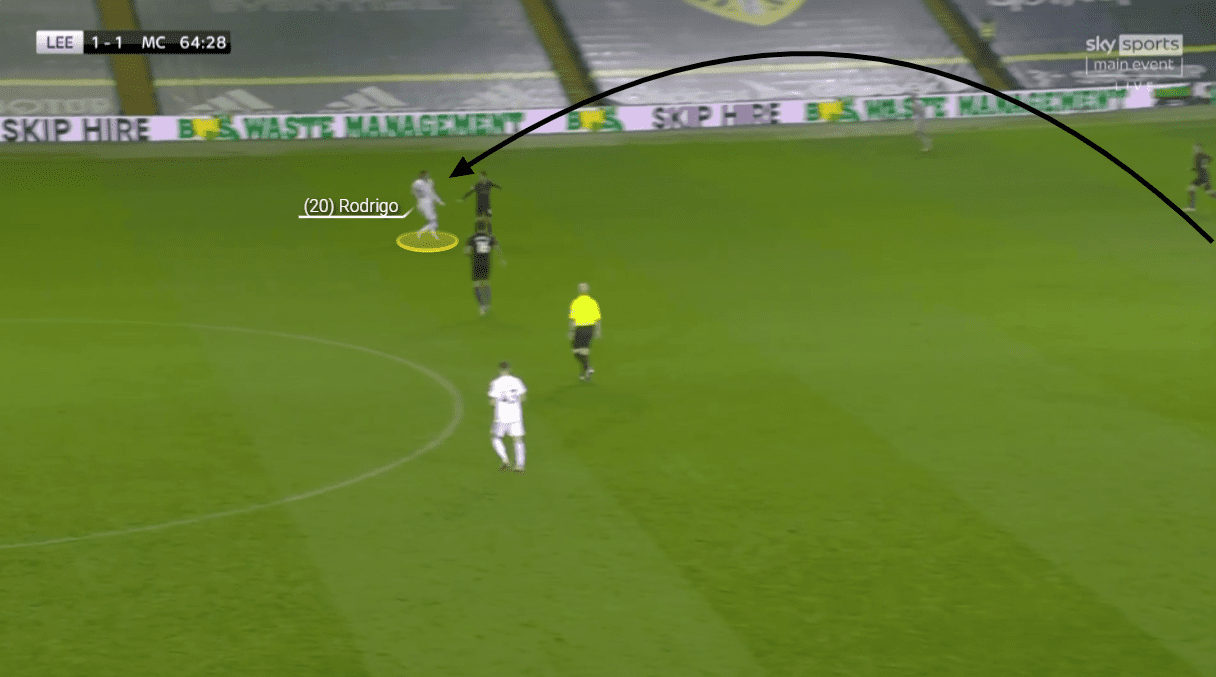
A similar situation as that of the first half when Meslier played a long ball to Klich, blindside of the City midfielders, and the Polish international misjudged the weight of the pass and lost the ball. However, in the second half, Rodrigo was used in these spaces and as seen in the image above, he brought down the ball beautifully with his chest.
The other structure Leeds took was Klich in the half space but much deeper to implement the 3rd man principle and Rodrigo in the central channel.

Klich would initially position higher in the half space and drop deep instantly to open up a passing lane for his centre-back or the goalkeeper.

Here, Koch played the ball to the dropping Klich who played the first time ball to Phillips, the 3rd man.

Rodrigo being in the blindside of Rodri made a movement opposite to the Man city midfielder and received the ball from the English midfielder.
Leeds implemented rotation with the midfielder dropping deep in the half space too.

Late in the second half, Leif Davis was subbed in for Klich. Davis occupied the left-back position and Dallas was pushed to Klich’s position. Here, again, Costa dropped deep supported his left-back, Davis. Davis used Costa as a bounce pass and received the ball.

Then Dallas and Costa rotated their position. Dallas exploited the unmarked left flank and played on Bamford. The striker failed to score one on one against Ederson and give Leeds all three points.
Conclusion
The match was an end to end affair with Leeds ending on a high note and probably should have won the game. Leeds attempted 12 shots with seven on target and Man City attempted a staggering 25 shots with only one on target, which states City’s struggle in front of the goal without Sergio Agüeroand Gabriel Jesus.
Leeds vs Manchester City was more of a game where each team tried to break the other’s build-up by pressing high and whoever did it better looked the better side. Man City choked Leeds with their high block in the first half and looked the much better side while Leeds devised ways to break the Man City block and looked the much better side in the second half.
The master vs mister ended up in a draw but the game of football the fans witnessed will be etched in the memory for long.






Comments